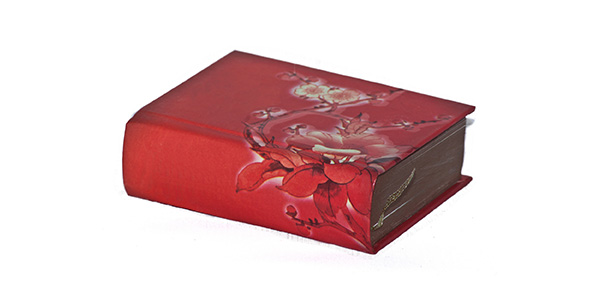Related Flashcards
Related Topics
Cards In This Set
| Front | Back |
|
Votive
|
Statues that represented the people's souls. Often left in the ziggurat and represented the people.
|
|
Stela(e)
|
A stone or wooden slab, generally taller than it is wide, erected for funerals or commemorative purposes, most usually decorated with the names and titles of the deceased or living — inscribed, carved in relief (bas-relief, sunken-relief, high-relief, and so forth), or painted onto the slab. It can also be used as territorial markers to delineate land ownership.
|
|
Ziggurat
|
Were massive structures built in the ancient Mesopotamian valley and western Iranian plateau, having the form of a terraced step pyramid of successively receding stories or levels.
|
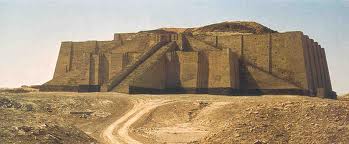 What is this? |
Ziggurat, Ur, Iraq, ca 2100 BCE, Sumerian
looks like a tomb but is a shrine/temple with a gigantic platform about 5 stories high - 190 x 130 feet base core of solid mud brick and the outside/facade is smaller mud brick with bitumen (a tar like substance) this ziggurat is dedicated to Nana is the moon god ziggurats are places for people to interact with God |
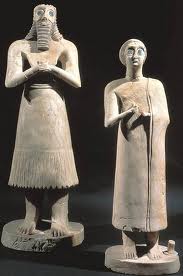 What is this? |
Two Worshippers from Temple of Eshnunna, Iraq, Sumerian, ca 2700 BCE
a series of these figures (approx 30) votive statue is there to provide continual worship to a deity large eyes-- alabaster |
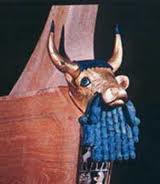 What is this? |
Bull-headed Lyre from Tomb 789, Royal Cemetery, Ur, Iraq, ca. 2600 BCEFormed over wood and covered in Gold with details in Lapis Lazuli
only two Lapis mines in the world -- still functioning in Afghanistan lot of impurities in Lapis -- you would have to grind very fine but the finer you grind it the less saturated the color. Front inlay includes four horizontel registers lowest-scorpion-man holding two objects followed by a billy goat standing on hind legs with two cups next layer - donkey upright playing lyre and a bear-like figure holding it up with a Dog on hind legs presenting a feast followed by a lion carrying a glass of wine top layer a man holding two bulls with human heads because the animals are transmorgified the scholors believe this is a depictions of the world of the dead (also was found in grave) |
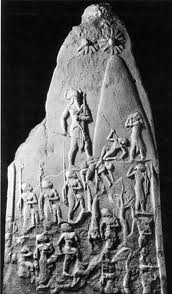 What is this? |
Victory Stele of Naram-Sin, from Susa, Iran, Akkadian, 2254-2218 BCE2ne ruler of Akkadian
hieratic scale -- Naram-Sin bigger than other figures |
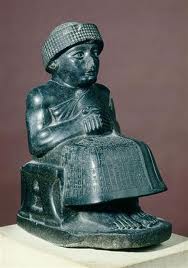 What is this? |
Seated statue of Gudea holding temple plan, Girsu, Iraq, ca 21000
Lagash was a left-over city/state made from diarite had 30 or 40 of these forms (votives) created for him Cuneiform inscription dedicating himself and the form to the goddess of dream readers |
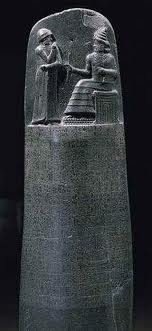 What is this |
Stele of Hammarabi
Hammarabi and Shamash Law Stele from Susa, Iran, Babylonian ca. 1780 BCE Hammarabi reunites Sumer and the capital city becomes Babylon Hammarabi is famous for building the code/law that is on stele in cuneiform Hammarabi faces shamash in a very confident way in the Louvre now |
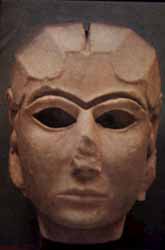 What is this? |
Female Head (Inanna? goddess of love and war) from Uruk, Iraq ca 3200 - 3000BCE
marble 360 work - not mask - think that there was a body with it (votive statue) |
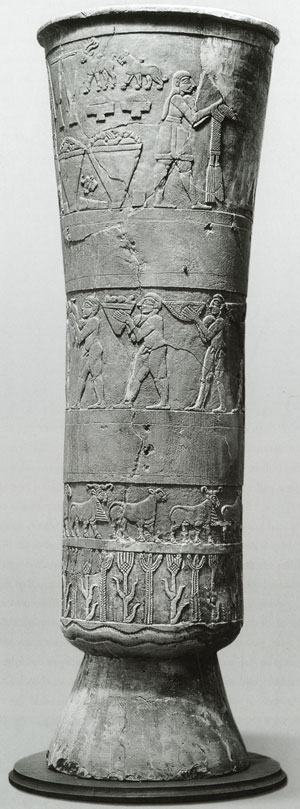 Warka Vase |
Warka Vase -- presentation of offerings to Inanna, from Uruk, Iraq, Sumerian, CA 3200-3000
alabaster approx 3.5 feet shows registers Inanna is the most important female diety (godess of love and war) and transforms into Ishtar divided vase in low relief |
|
Hieratic Scaling
|
Representing the sizes of things according to their importance, rather than how they would appear in the real world
|
|
Register
|
Bands - provides an organization that you can read and understand as opposed to cave paintings which had no organizations to understand the importance of each element in the piece.
|
|
Low relief
|
Shallow carving
|
|
What is this?
|
Head of a ruler from Nineveh, Iraq, Akkadian, copper CA 2250-2200
head of a man (separated from body) huge variation of texture -- |



